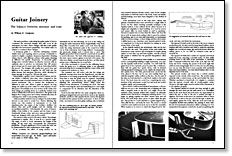
Synopsis: A major problem confronting guitarmakers is how to counteract structural changes that will occur in the instrument over time. These changes alter tonal quality and affect its playability, so the builder relies on joinery to counteract the changes. In this article, William R. Cumpiano talks about factors that affect how a builder chooses to join the neck and sound box, and why that’s a critical decision. He says that neck/body joints fall into two main categories: those requiring an integral heel and neck block, such as the Spanish method, and those with separate block, such as the tapered dovetail and the pinned mortise and tenon. He explains the latter two joints, and other simpler joints in other parts of the guitar.
The major problem confronting the guitar maker is how to counteract the structural changes that will occur in his instrument over time. These changes will alter tonal quality and affect the instrument’s playability. The builder relies on joinery to counteract these changes.
A strung-up guitar is a structure undergoing constant sizable stress and requiring utmost economy of materials to render it a highly compliant, frequency-dependent vibrating object—that is, with different sections of the guitar vibrating at different but specific frequencies. A successful guitar design must correctly balance an effective structure with an optimum mass to produce an instrument that will project good strong tone for many years without destroying itself in the process. The designer will usually favor good tone and lightness at the expense of rigidity. He will build into the guitar features that anticipate distortion while allowing for repair through its hoped for 100-year life span.
Interestingly, a guitar’s tone is expected to mature and decay within a relatively short time, short compared to the maturation span of several hundred years of violins and other bowed instruments. This is because the architecture is different in each case. When a guitar is played, six long strings are pulled up at the center of a wide expanse of very thin spruce of essentially even cross section. In the violin, four short strings are pushing down on a perfectly vaulted cross section of fairly thick and narrow dimension. The guitar body fatigues first, losing power and volume dramatically when its contemporary violin is just passing adolescence.
Guitar assembly methods vary according to how the builder chooses to join neck to sound box. Factors affecting this choice are: the number of instruments to be built simultaneously, the extent of the builder’s facilities, his talents, time and profit margin, and his training and accumulated prejudices. Unfortunately, the sense of responsibility of the builder to his creation and his buyer is predominantly absent today, and most mass-produced instruments are designed with only profit in mind.
The selection of the neck/body joint is critical. The primary requirement is rigidity. Also, it must fit at a precise angle. The angle of neck to body determines the height of the strings off the neck and consequently the instrument’s playability. Of equal significance is how easily the joint can be disassembled for later readjustment of the angle.
From Fine Woodworking #5
For the full article, download the PDF below:
Fine Woodworking Recommended Products

Suizan Japanese Pull Saw

Starrett 4" Double Square

Festool DF 500 Q-Set Domino Joiner






















Log in or create an account to post a comment.
Sign up Log in